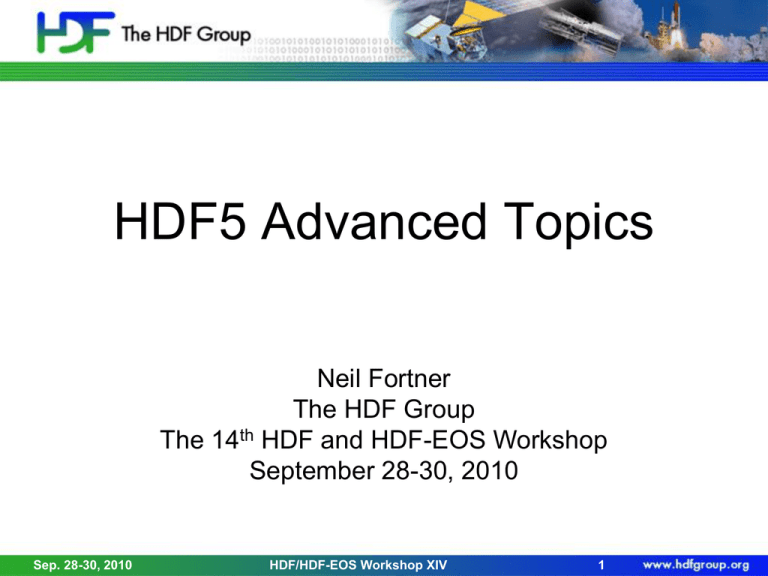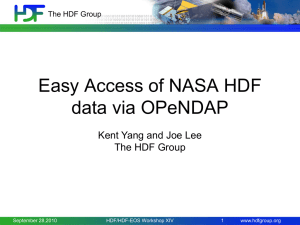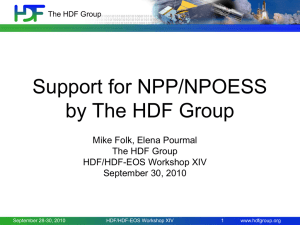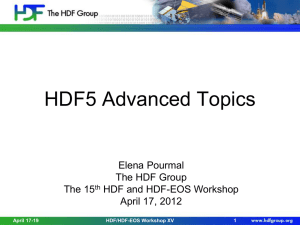Presentation - HDF-EOS Tools and Information Center
advertisement

HDF5 Advanced Topics
Neil Fortner
The HDF Group
The 14th HDF and HDF-EOS Workshop
September 28-30, 2010
Sep. 28-30, 2010
HDF/HDF-EOS Workshop XIV
1
Outline
• Overview of HDF5 datatypes
• Partial I/O in HDF5
• Chunking and compression
Sep. 28-30, 2010
HDF/HDF-EOS Workshop XIV
2
HDF5 Datatypes
Quick overview of the most
difficult topics
Sep. 28-30, 2010
HDF/HDF-EOS Workshop XIV
3
An HDF5 Datatype is…
• A description of dataset element type
• Grouped into “classes”:
•
•
•
•
•
•
Atomic – integers, floating-point values
Enumerated
Compound – like C structs
Array
Opaque
References
• Object – similar to soft link
• Region – similar to soft link to dataset + selection
• Variable-length
• Strings – fixed and variable-length
• Sequences – similar to Standard C++ vector class
Sep. 28-30, 2010
HDF/HDF-EOS Workshop XIV
4
HDF5 Datatypes
• HDF5 has a rich set of pre-defined datatypes and
supports the creation of an unlimited variety of
complex user-defined datatypes.
• Self-describing:
• Datatype definitions are stored in the HDF5 file
with the data.
• Datatype definitions include information such as
byte order (endianness), size, and floating point
representation to fully describe how the data is
stored and to insure portability across platforms.
Sep. 28-30, 2010
HDF/HDF-EOS Workshop XIV
5
Datatype Conversion
• Datatypes that are compatible, but not identical
are converted automatically when I/O is
performed
• Compatible datatypes:
• All atomic datatypes are compatible
• Identically structured array, variable-length and
compound datatypes whose base type or fields are
compatible
• Enumerated datatype values on a “by name” basis
• Make datatypes identical for best performance
Sep. 28-30, 2010
HDF/HDF-EOS Workshop XIV
6
Datatype Conversion Example
Array of integers on IA32 platform
Native integer is little-endian, 4 bytes
Array of integers on SPARC64 platform
Native integer is big-endian, 8 bytes
H5T_NATIVE_INT
H5T_NATIVE_INT
Little-endian 4 bytes integer
H5Dwrite
H5Dread
H5Dwrite
H5T_STD_I32LE
Sep. 28-30, 2010
HDF/HDF-EOS Workshop XIV
VAX G-floating
7
Datatype Conversion
Datatype of data on disk
dataset = H5Dcreate(file, DATASETNAME, H5T_STD_I64BE,
space, H5P_DEFAULT, H5P_DEFAULT);
Datatype of data in memory buffer
H5Dwrite(dataset, H5T_NATIVE_INT, H5S_ALL, H5S_ALL,
H5P_DEFAULT, buf);
H5Dwrite(dataset, H5T_NATIVE_DOUBLE, H5S_ALL, H5S_ALL,
H5P_DEFAULT, buf);
Sep. 28-30, 2010
HDF/HDF-EOS Workshop XIV
8
Storing Records with HDF5
Sep. 28-30, 2010
HDF/HDF-EOS Workshop XIV
9
HDF5 Compound Datatypes
• Compound types
• Comparable to C structs
• Members can be any datatype
• Can write/read by a single field or a set of fields
• Not all data filters can be applied (shuffling,
SZIP)
Sep. 28-30, 2010
HDF/HDF-EOS Workshop XIV
10
Creating and Writing Compound Dataset
h5_compound.c example
typedef struct s1_t {
int a;
float b;
double c;
} s1_t;
s1_t
Sep. 28-30, 2010
s1[LENGTH];
HDF/HDF-EOS Workshop XIV
11
Creating and Writing Compound Dataset
/* Create datatype in memory. */
s1_tid = H5Tcreate(H5T_COMPOUND, sizeof(s1_t));
H5Tinsert(s1_tid, "a_name", HOFFSET(s1_t, a),
H5T_NATIVE_INT);
H5Tinsert(s1_tid, "c_name", HOFFSET(s1_t, c),
H5T_NATIVE_DOUBLE);
H5Tinsert(s1_tid, "b_name", HOFFSET(s1_t, b),
H5T_NATIVE_FLOAT);
Note:
• Use HOFFSET macro instead of calculating offset by hand.
• Order of H5Tinsert calls is not important if HOFFSET is used.
Sep. 28-30, 2010
HDF/HDF-EOS Workshop XIV
12
Creating and Writing Compound Dataset
/* Create dataset and write data */
dataset = H5Dcreate(file, DATASETNAME, s1_tid, space,
H5P_DEFAULT, H5P_DEFAULT);
status = H5Dwrite(dataset, s1_tid, H5S_ALL, H5S_ALL,
H5P_DEFAULT, s1);
Note:
• In this example memory and file datatypes are the same.
• Type is not packed.
• Use H5Tpack to save space in the file.
status = H5Tpack(s1_tid);
status = H5Dcreate(file, DATASETNAME, s1_tid, space,
H5P_DEFAULT, H5P_DEFAULT);
Sep. 28-30, 2010
HDF/HDF-EOS Workshop XIV
13
Reading Compound Dataset
/* Create datatype in memory and read data. */
dataset
= H5Dopen(file, DATASETNAME, H5P_DEFAULT);
s2_tid
= H5Dget_type(dataset);
mem_tid
= H5Tget_native_type(s2_tid);
buf = malloc(H5Tget_size(mem_tid)*number_of_elements);
status
= H5Dread(dataset, mem_tid, H5S_ALL,
H5S_ALL, H5P_DEFAULT, buf);
Note:
• We could construct memory type as we did in writing example.
• For general applications we need to discover the type in the
file, find out corresponding memory type, allocate space and do
read.
Sep. 28-30, 2010
HDF/HDF-EOS Workshop XIV
14
Reading Compound Dataset by Fields
typedef struct s2_t {
double c;
int
a;
} s2_t;
s2_t s2[LENGTH];
…
s2_tid = H5Tcreate (H5T_COMPOUND, sizeof(s2_t));
H5Tinsert(s2_tid, "c_name", HOFFSET(s2_t, c),
H5T_NATIVE_DOUBLE);
H5Tinsert(s2_tid, “a_name", HOFFSET(s2_t, a),
H5T_NATIVE_INT);
…
status = H5Dread(dataset, s2_tid, H5S_ALL,
H5S_ALL, H5P_DEFAULT, s2);
Sep. 28-30, 2010
HDF/HDF-EOS Workshop XIV
15
Table Example
a_name b_name c_name Multiple ways to store a table
(integer) (float) (double) • Dataset for each field
0
1
2
0.
1.
4.
1.0000
0.5000
0.3333
• Dataset with compound datatype
• If all fields have the same type:
◦ 2-dim array
◦ 1-dim array of array datatype
• Continued…
3
4
5
9.
16.
25.
0.2500
0.2000
0.1667
Choose to achieve your goal!
6
7
8
36.
49.
64.
0.1429
0.1250
0.1111
9
81.
0.1000
Sep. 28-30, 2010
•
•
•
•
•
Storage overhead?
Do I always read all fields?
Do I read some fields more often?
Do I want to use compression?
Do I want to access some records?
HDF/HDF-EOS Workshop XIV
16
Storing Variable Length
Data with HDF5
Sep. 28-30, 2010
HDF/HDF-EOS Workshop XIV
17
HDF5 Fixed and Variable Length Array Storage
•Data
•Data
Time
•Data
•Data
•Data
•Data
Time
•Data
•Data
•Data
Sep. 28-30, 2010
HDF/HDF-EOS Workshop XIV
18
Storing Variable Length Data in HDF5
• Each element is represented by C structure
typedef struct {
size_t length;
void
*p;
} hvl_t;
• Base type can be any HDF5 type
H5Tvlen_create(base_type)
Sep. 28-30, 2010
HDF/HDF-EOS Workshop XIV
19
Example
hvl_t
data[LENGTH];
for(i=0; i<LENGTH; i++) {
data[i].p = malloc((i+1)*sizeof(unsigned int));
data[i].len = i+1;
}
tvl = H5Tvlen_create (H5T_NATIVE_UINT);
data[0].p
•Data
•Data
•Data
•Data
data[4].len
Sep. 28-30, 2010
•Data
HDF/HDF-EOS Workshop XIV
20
Reading HDF5 Variable Length Array
• HDF5 library allocates memory to read data in
• Application only needs to allocate array of hvl_t
elements (pointers and lengths)
• Application must reclaim memory for data read in
hvl_t rdata[LENGTH];
/* Create the memory vlen type */
tvl = H5Tvlen_create(H5T_NATIVE_INT);
ret = H5Dread(dataset, tvl, H5S_ALL, H5S_ALL,
H5P_DEFAULT, rdata);
/* Reclaim the read VL data */
H5Dvlen_reclaim(tvl, H5S_ALL, H5P_DEFAULT,rdata);
Sep. 28-30, 2010
HDF/HDF-EOS Workshop XIV
21
Variable Length vs. Array
• Pros of variable length datatypes vs. arrays:
• Uses less space if compression unavailable
• Automatically stores length of data
• No maximum size
• Size of an array is its effective maximum size
• Cons of variable length datatypes vs. arrays:
• Substantial performance overhead
• Each element a “pointer” to piece of metadata
• Variable length data cannot be compressed
• Unused space in arrays can be “compressed away”
• Must be 1-dimensional
Sep. 28-30, 2010
HDF/HDF-EOS Workshop XIV
22
Storing Strings in HDF5
Sep. 28-30, 2010
HDF/HDF-EOS Workshop XIV
23
Storing Strings in HDF5
• Array of characters (Array datatype or extra dimension in
dataset)
• Quick access to each character
• Extra work to access and interpret each string
• Fixed length
string_id = H5Tcopy(H5T_C_S1);
H5Tset_size(string_id, size);
• Wasted space in shorter strings
• Can be compressed
• Variable length
string_id = H5Tcopy(H5T_C_S1);
H5Tset_size(string_id, H5T_VARIABLE);
• Overhead as for all VL datatypes
• Compression will not be applied to actual data
Sep. 28-30, 2010
HDF/HDF-EOS Workshop XIV
24
HDF5 Reference Datatypes
Sep. 28-30, 2010
HDF/HDF-EOS Workshop XIV
25
Reference Datatypes
• Object Reference
• Pointer to an object in a file
• Predefined datatype H5T_STD_REG_OBJ
• Dataset Region Reference
• Pointer to a dataset + dataspace selection
• Predefined datatype
H5T_STD_REF_DSETREG
Sep. 28-30, 2010
HDF/HDF-EOS Workshop XIV
26
Saving Selected Region in a File
Need to select and access the same
elements of a dataset
Sep. 28-30, 2010
HDF/HDF-EOS Workshop XIV
27
Reference to Dataset Region
REF_REG.h5
Root
Matrix
Region References
1 1 2 3 3 4 5 5 6
1 2 2 3 4 4 5 6 6
Sep. 28-30, 2010
HDF/HDF-EOS Workshop XIV
28
Working with subsets
Sep. 28-30, 2010
HDF/HDF-EOS Workshop XIV
30
Collect data one way ….
Array of images (3D)
Sep. 28-30, 2010
HDF/HDF-EOS Workshop XIV
31
Display data another way …
Stitched image (2D array)
Sep. 28-30, 2010
HDF/HDF-EOS Workshop XIV
32
Data is too big to read….
Sep. 28-30, 2010
HDF/HDF-EOS Workshop XIV
33
HDF5 Library Features
• HDF5 Library provides capabilities to
• Describe subsets of data and perform write/read
operations on subsets
• Hyperslab selections and partial I/O
• Store descriptions of the data subsets in a file
• Object references
• Region references
• Use efficient storage mechanism to achieve good
performance while writing/reading subsets of data
• Chunking, compression
Sep. 28-30, 2010
HDF/HDF-EOS Workshop XIV
34
Partial I/O in HDF5
Sep. 28-30, 2010
HDF/HDF-EOS Workshop XIV
35
How to Describe a Subset in HDF5?
• Before writing and reading a subset of data
one has to describe it to the HDF5 Library.
• HDF5 APIs and documentation refer to a
subset as a “selection” or “hyperslab
selection”.
• If specified, HDF5 Library will perform I/O on a
selection only and not on all elements of a
dataset.
Sep. 28-30, 2010
HDF/HDF-EOS Workshop XIV
36
Types of Selections in HDF5
• Two types of selections
• Hyperslab selection
• Regular hyperslab
• Simple hyperslab
• Result of set operations on hyperslabs (union,
difference, …)
• Point selection
• Hyperslab selection is especially important for
doing parallel I/O in HDF5 (See Parallel HDF5
Tutorial)
Sep. 28-30, 2010
HDF/HDF-EOS Workshop XIV
37
Regular Hyperslab
Collection of regularly spaced equal size blocks
Sep. 28-30, 2010
HDF/HDF-EOS Workshop XIV
38
Simple Hyperslab
Contiguous subset or sub-array
Sep. 28-30, 2010
HDF/HDF-EOS Workshop XIV
39
Hyperslab Selection
Result of union operation on three simple hyperslabs
Sep. 28-30, 2010
HDF/HDF-EOS Workshop XIV
40
Hyperslab Description
• Start - starting location of a hyperslab (1,1)
• Stride - number of elements that separate each
block (3,2)
• Count - number of blocks (2,6)
• Block - block size (2,1)
• Everything is “measured” in number of elements
Sep. 28-30, 2010
HDF/HDF-EOS Workshop XIV
41
Simple Hyperslab Description
• Two ways to describe a simple hyperslab
• As several blocks
• Stride – (1,1)
• Count – (4,6)
• Block – (1,1)
• As one block
• Stride – (1,1)
• Count – (1,1)
• Block – (4,6)
No performance penalty for
one way or another
Sep. 28-30, 2010
HDF/HDF-EOS Workshop XIV
42
H5Sselect_hyperslab Function
space_id Identifier of dataspace
op
Selection operator
H5S_SELECT_SET or H5S_SELECT_OR
start
Array with starting coordinates of hyperslab
stride
Array specifying which positions along a dimension
to select
count
Array specifying how many blocks to select from the
dataspace, in each dimension
block
Array specifying size of element block
(NULL indicates a block size of a single element in
a dimension)
Sep. 28-30, 2010
HDF/HDF-EOS Workshop XIV
43
Reading/Writing Selections
Programming model for reading from a dataset in
a file
1. Open a dataset.
2. Get file dataspace handle of the dataset and specify
subset to read from.
a. H5Dget_space returns file dataspace handle
a.
File dataspace describes array stored in a file (number of
dimensions and their sizes).
b. H5Sselect_hyperslab selects elements of the array
that participate in I/O operation.
3. Allocate data buffer of an appropriate shape and size
Sep. 28-30, 2010
HDF/HDF-EOS Workshop XIV
44
Reading/Writing Selections
Programming model (continued)
4. Create a memory dataspace and specify subset to write
to.
1.
2.
Memory dataspace describes data buffer (its rank and
dimension sizes).
Use H5Screate_simple function to create memory
dataspace.
Use H5Sselect_hyperslab to select elements of the data
buffer that participate in I/O operation.
Issue H5Dread or H5Dwrite to move the data between
3.
5.
file and memory buffer.
6. Close file dataspace and memory dataspace when
done.
Sep. 28-30, 2010
HDF/HDF-EOS Workshop XIV
45
Example : Reading Two Rows
1
2
3
4
5
6
7
8
9
10
11
12
13
14
15
16
17
18
19
20
21
22
23
24
-1
-1
-1
Data in a file
4x6 matrix
Buffer in memory
1-dim array of length 14
-1
-1
Sep. 28-30, 2010
-1
-1
-1
-1
-1
HDF/HDF-EOS Workshop XIV
-1
-1
46
-1
-1
Example: Reading Two Rows
1
2
3
4
5
6
7
8
9
10
11
12
13
14
15
16
17
18
19
20
21
22
23
24
start
count
block
stride
filespace = H5Dget_space (dataset);
H5Sselect_hyperslab (filespace, H5S_SELECT_SET,
start, NULL, count, NULL)
Sep. 28-30, 2010
HDF/HDF-EOS Workshop XIV
47
=
=
=
=
{1,0}
{2,6}
{1,1}
{1,1}
Example: Reading Two Rows
start[1] = {1}
count[1] = {12}
dim[1]
= {14}
-1
-1
-1
-1
-1
-1
-1
-1
-1
-1
-1
-1
memspace = H5Screate_simple(1, dim, NULL);
H5Sselect_hyperslab (memspace, H5S_SELECT_SET,
start, NULL, count, NULL)
Sep. 28-30, 2010
HDF/HDF-EOS Workshop XIV
48
-1
-1
Example: Reading Two Rows
1
2
3
4
5
6
7
8
9
10
11
12
13
14
15
16
17
18
19
20
21
22
23
24
H5Dread (…, …, memspace, filespace, …, …);
-1
7
Sep. 28-30, 2010
8
9
10 11 12 13 14 15 16 17 18 -1
HDF/HDF-EOS Workshop XIV
49
Things to Remember
• Number of elements selected in a file and in a
memory buffer must be the same
• H5Sget_select_npoints returns number of
selected elements in a hyperslab selection
• HDF5 partial I/O is tuned to move data between
selections that have the same dimensionality;
avoid choosing subsets that have different ranks
(as in example above)
• Allocate a buffer of an appropriate size when
reading data; use H5Tget_native_type and
H5Tget_size to get the correct size of the data
element in memory.
Sep. 28-30, 2010
HDF/HDF-EOS Workshop XIV
50
Chunking in HDF5
Sep. 28-30, 2010
HDF/HDF-EOS Workshop XIV
51
HDF5 Dataset
Metadata
Dataset data
Dataspace
Rank Dimensions
3
Dim_1 = 4
Dim_2 = 5
Dim_3 = 7
Datatype
IEEE 32-bit float
Attributes
Storage info
Time = 32.4
Chunked
Pressure = 987
Compressed
Temp = 56
Sep. 28-30, 2010
HDF/HDF-EOS Workshop XIV
52
Contiguous storage layout
• Metadata header separate from dataset data
• Data stored in one contiguous block in HDF5 file
Metadata cache
Dataset header
………….
Datatype
Dataspace
………….
Attributes
…
Dataset data
Application memory
File
Sep. 28-30, 2010
Dataset data
HDF/HDF-EOS Workshop XIV
53
What is HDF5 Chunking?
• Data is stored in chunks of predefined size
• Two-dimensional instance may be referred to as
data tiling
• HDF5 library usually writes/reads the whole chunk
Contiguous
Sep. 28-30, 2010
HDF/HDF-EOS Workshop XIV
Chunked
54
What is HDF5 Chunking?
• Dataset data is divided into equally sized blocks (chunks).
• Each chunk is stored separately as a contiguous block in
HDF5 file.
Metadata cache
Dataset data
Dataset header
………….
Datatype
Dataspace
………….
Attributes
…
File
Sep. 28-30, 2010
A
B
C
D
Chunk
index
Application memory
header
Chunk
index
A
HDF/HDF-EOS Workshop XIV
C
D
B
55
Why HDF5 Chunking?
• Chunking is required for several HDF5 features
• Enabling compression and other filters like
checksum
• Extendible datasets
Sep. 28-30, 2010
HDF/HDF-EOS Workshop XIV
56
Why HDF5 Chunking?
• If used appropriately chunking improves partial
I/O for big datasets
Only two chunks are involved in I/O
Sep. 28-30, 2010
HDF/HDF-EOS Workshop XIV
57
Creating Chunked Dataset
1.
2.
3.
Create a dataset creation property list.
Set property list to use chunked storage layout.
Create dataset with the above property list.
dcpl_id = H5Pcreate(H5P_DATASET_CREATE);
rank = 2;
ch_dims[0] = 100;
ch_dims[1] = 200;
H5Pset_chunk(dcpl_id, rank, ch_dims);
dset_id = H5Dcreate (…, dcpl_id);
H5Pclose(dcpl_id);
Sep. 28-30, 2010
HDF/HDF-EOS Workshop XIV
58
Creating Chunked Dataset
• Things to remember:
• Chunk always has the same rank as a dataset
• Chunk’s dimensions do not need to be factors
of dataset’s dimensions
• Caution: May cause more I/O than desired
(see white portions of the chunks below)
Sep. 28-30, 2010
HDF/HDF-EOS Workshop XIV
59
Creating Chunked Dataset
• Chunk size cannot be changed after the dataset is
created
• Do not make chunk sizes too small (e.g. 1x1)!
• Metadata overhead for each chunk (file space)
• Each chunk is read individually
• Many small reads inefficient
Sep. 28-30, 2010
HDF/HDF-EOS Workshop XIV
60
Writing or Reading Chunked Dataset
1.
2.
Chunking mechanism is transparent to application.
Use the same set of operation as for contiguous
dataset, for example,
H5Dopen(…);
H5Sselect_hyperslab (…);
H5Dread(…);
3.
Selections do not need to coincide precisely with the
chunks boundaries.
Sep. 28-30, 2010
HDF/HDF-EOS Workshop XIV
61
HDF5 Chunking and compression
•
Chunking is required for compression and
other filters
HDF5 filters modify data during I/O operations
Filters provided by HDF5:
•
•
•
•
•
•
Checksum (H5Pset_fletcher32)
Data transformation (in 1.8.*)
Shuffling filter (H5Pset_shuffle)
Compression (also called filters) in HDF5
•
•
•
•
Sep. 28-30, 2010
Scale + offset (in 1.8.*) (H5Pset_scaleoffset)
N-bit (in 1.8.*) (H5Pset_nbit)
GZIP (deflate) (H5Pset_deflate)
SZIP (H5Pset_szip)
HDF/HDF-EOS Workshop XIV
62
HDF5 Third-Party Filters
• Compression methods supported by
HDF5 User’s community
http://wiki.hdfgroup.org/Community-Support-for-HDF5
•
LZO lossless compression (PyTables)
•
BZIP2 lossless compression (PyTables)
•
BLOSC lossless compression (PyTables)
•
LZF lossless compression H5Py
Sep. 28-30, 2010
HDF/HDF-EOS Workshop XIV
63
Creating Compressed Dataset
1.
2.
3.
4.
Create a dataset creation property list
Set property list to use chunked storage layout
Set property list to use filters
Create dataset with the above property list
dcpl_id = H5Pcreate(H5P_DATASET_CREATE);
rank = 2;
ch_dims[0] = 100;
ch_dims[1] = 100;
H5Pset_chunk(dcpl_id, rank, ch_dims);
H5Pset_deflate(dcpl_id, 9);
dset_id = H5Dcreate (…, dcpl_id);
H5Pclose(dcpl_id);
Sep. 28-30, 2010
HDF/HDF-EOS Workshop XIV
64
Performance Issues
or
What everyone needs to know
about chunking and the chunk
cache
Sep. 28-30, 2010
HDF/HDF-EOS Workshop XIV
65
Accessing a row in contiguous dataset
One seek is needed to find the starting location of row of data.
Data is read/written using one disk access.
Sep. 28-30, 2010
HDF/HDF-EOS Workshop XIV
66
Accessing a row in chunked dataset
Five seeks is needed to find each chunk. Data is read/written
using five disk accesses. Chunking storage is less efficient
than contiguous storage.
Sep. 28-30, 2010
HDF/HDF-EOS Workshop XIV
67
Quiz time
• How might I improve this situation, if it is
common to access my data in this way?
Sep. 28-30, 2010
HDF/HDF-EOS Workshop XIV
68
Accessing data in contiguous dataset
M rows
M seeks are needed to find the starting location of the element.
Data is read/written using M disk accesses. Performance may be
very bad.
Sep. 28-30, 2010
HDF/HDF-EOS Workshop XIV
69
Motivation for chunking storage
M rows
Two seeks are needed to find two chunks. Data is
read/written using two disk accesses. For this pattern
chunking helps with I/O performance.
Sep. 28-30, 2010
HDF/HDF-EOS Workshop XIV
70
Motivation for chunk cache
A
B
H5Dwrite
H5Dwrite
Selection shown is written by two H5Dwrite calls (one for
each row).
Chunks A and B are accessed twice (one time for each
row). If both chunks fit into cache, only two I/O accesses
needed to write the shown selections.
Sep. 28-30, 2010
HDF/HDF-EOS Workshop XIV
71
Motivation for chunk cache
A
B
H5Dwrite
H5Dwrite
Question: What happens if there is a space for only one
chunk at a time?
Sep. 28-30, 2010
HDF/HDF-EOS Workshop XIV
72
Advanced Exercise
•
•
•
•
Write data to a dataset
Dataset is 512x2048, 4-byte native integers
Chunks are 256x128: 128KB each, 2MB rows
Write by rows
Sep. 28-30, 2010
HDF/HDF-EOS Workshop XIV
73
Advanced Exercise
• Very slow performance
• What is going wrong?
• Chunk cache is only 1MB by default
Read into cache
Sep. 28-30, 2010
HDF/HDF-EOS Workshop XIV
74
Advanced Exercise
• Very slow performance
• What is going wrong?
• Chunk cache is only 1MB by default
Write to disk
Sep. 28-30, 2010
Read into cache
HDF/HDF-EOS Workshop XIV
75
Advanced Exercise
• Very slow performance
• What is going wrong?
• Chunk cache is only 1MB by default
Write to disk
Sep. 28-30, 2010
Read into cache
HDF/HDF-EOS Workshop XIV
76
Advanced Exercise
• Very slow performance
• What is going wrong?
• Chunk cache is only 1MB by default
Write to disk
Sep. 28-30, 2010
Read into cache
HDF/HDF-EOS Workshop XIV
77
Advanced Exercise
• Very slow performance
• What is going wrong?
• Chunk cache is only 1MB by default
Write to disk
Sep. 28-30, 2010
HDF/HDF-EOS Workshop XIV
Read into cache
78
Advanced Exercise
• Very slow performance
• What is going wrong?
• Chunk cache is only 1MB by default
Write to disk
Sep. 28-30, 2010
HDF/HDF-EOS Workshop XIV
Read into cache
79
Advanced Exercise
• Very slow performance
• What is going wrong?
• Chunk cache is only 1MB by default
Read into cache
Sep. 28-30, 2010
Write to disk
HDF/HDF-EOS Workshop XIV
80
Advanced Exercise
• Very slow performance
• What is going wrong?
• Chunk cache is only 1MB by default
Read into cache
Sep. 28-30, 2010
Write to disk
HDF/HDF-EOS Workshop XIV
81
Exercise 1
• Improve performance by changing only chunk
size
Access pattern is fixed, limited memory
• One solution: 64x2048 chunks
• Row of chunks fits in cache
Sep. 28-30, 2010
HDF/HDF-EOS Workshop XIV
82
Exercise 2
• Improve performance by changing only access
pattern
• File already exists, cannot change chunk size
• One solution: Access by chunk
• Each selection fits in cache, contiguous on disk
Sep. 28-30, 2010
HDF/HDF-EOS Workshop XIV
83
Exercise 3
• Improve performance while not changing chunk
size or access pattern
• No memory limitation
• One solution: Chunk cache set to size of row of
chunks
Sep. 28-30, 2010
HDF/HDF-EOS Workshop XIV
84
Exercise 4
• Improve performance while not changing chunk
size or access pattern
• Chunk cache size can be set to max. 1MB
• One solution: Disable chunk cache
• Avoids repeatedly reading/writing whole chunks
Sep. 28-30, 2010
HDF/HDF-EOS Workshop XIV
85
More Information
• More detailed information on chunking and the
chunk cache can be found in the draft “Chunking
in HDF5” document at:
http://www.hdfgroup.org/HDF5/doc/_topic/Chunking
Sep. 28-30, 2010
HDF/HDF-EOS Workshop XIV
86
Thank You!
Sep. 28-30, 2010
HDF/HDF-EOS Workshop XIV
87
Acknowledgements
This work was supported by cooperative agreement
number NNX08AO77A from the National
Aeronautics and Space Administration (NASA).
Any opinions, findings, conclusions, or
recommendations expressed in this material are
those of the author[s] and do not necessarily reflect
the views of the National Aeronautics and Space
Administration.
Sep. 28-30, 2010
HDF/HDF-EOS Workshop XIV
88
Questions/comments?
Sep. 28-30, 2010
HDF/HDF-EOS Workshop XIV
89






